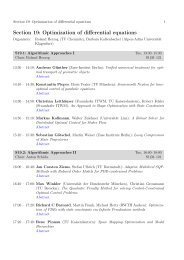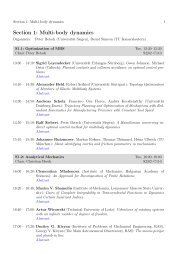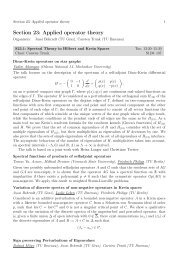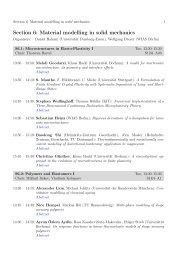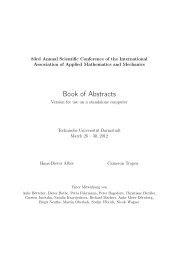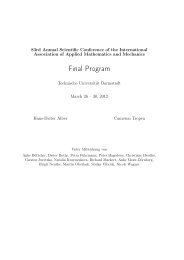Section 6: Material modelling in solid mechanics - GAMM 2012
Section 6: Material modelling in solid mechanics - GAMM 2012
Section 6: Material modelling in solid mechanics - GAMM 2012
You also want an ePaper? Increase the reach of your titles
YUMPU automatically turns print PDFs into web optimized ePapers that Google loves.
<strong>Section</strong> 6: <strong>Material</strong> <strong>modell<strong>in</strong>g</strong> <strong>in</strong> <strong>solid</strong> <strong>mechanics</strong> 15<br />
Steady vibrations problems <strong>in</strong> the theory of viscoelasticity for Kelv<strong>in</strong>-Voigt materials<br />
with voids<br />
Maia M. Svanadze (Universität Gött<strong>in</strong>gen)<br />
Viscoelastic materials play an important role <strong>in</strong> many branches of eng<strong>in</strong>eer<strong>in</strong>g, technology and<br />
bio<strong>mechanics</strong>. The modern theories of viscoelasticity and thermoviscoelasticity for materials with<br />
microstructure have been a subject of <strong>in</strong>tensive study <strong>in</strong> recent years. Recently, the theory of<br />
thermoviscoelastic materials with voids is constructed by Iesan (2011).<br />
In this paper the l<strong>in</strong>ear theory of viscoelasticity for Kelv<strong>in</strong>-Voigt materials with voids is considered<br />
and the basic <strong>in</strong>ternal and external boundary value problems of steady vibrations are <strong>in</strong>vestigated.<br />
The formulae of <strong>in</strong>tegral representations of regular vectors are obta<strong>in</strong>ed. The s<strong>in</strong>gle-layer,<br />
double-layer and volume potentials are constructed and their basic properties are established.<br />
The uniqueness and existence of regular solutions of the boundary value problems are proved by<br />
means of the potential method.<br />
Modell<strong>in</strong>g of predeformation- and frequency-dependent material behavior of filled<br />
rubber under large predeformations superimposed with harmonic deformations of<br />
small amplitudes<br />
D. Wollscheid, A. Lion (Universität der Bundeswehr München)<br />
Viscoelastic materials show a frequency- and predeformation-dependent behavior under load<strong>in</strong>gs<br />
that consist of large predeformations with superimposed harmonic deformations of small amplitudes.<br />
In order to consider this materialbehavior, some static and dynamic experiments are<br />
developed. Based on Haupt & Lion [1] and Lion, Retka & Rendek [2] we <strong>in</strong>troduce a recently<br />
developed constitutive approach of f<strong>in</strong>ite viscoelasticity <strong>in</strong> the frequency doma<strong>in</strong> that is able to<br />
describe the frequency- and predeformation-dependent materialbehavior with respect to storageand<br />
loss-modulus. The constitutive equations are evaluated <strong>in</strong> the frequency doma<strong>in</strong> and geometrically<br />
l<strong>in</strong>earized <strong>in</strong> the neighbourhood of the predeformation. Furthermore a formulation for<br />
<strong>in</strong>compressible material behavior is <strong>in</strong>troduced and the correspond<strong>in</strong>g dynamic modulus tensors<br />
are derived. Besides constitutive <strong>modell<strong>in</strong>g</strong> and experiments, parameter identification and some<br />
numerical simulations are presented.<br />
[1] P. Haupt, A. Lion, On f<strong>in</strong>ite l<strong>in</strong>ear viscoelasticity of <strong>in</strong>compressible isotropic materials, Acta<br />
Mechanica 159 (2002), 87 – 124.<br />
[2] A. Lion, J.Retka, M.Rendek On the calculation of predeformation-dependent dynamic modulus<br />
tensors <strong>in</strong> f<strong>in</strong>ite nonl<strong>in</strong>ear viscoelasticity, Mechanics Research Communications 36<br />
(2009), 653 – 658.<br />
A multi-scale <strong>modell<strong>in</strong>g</strong> approach for bitum<strong>in</strong>ous asphalt<br />
Thorsten Schüler, Ralf Jänicke, Holger Steeb (Universität Bochum)<br />
Bitum<strong>in</strong>ous asphalt is a standard material e.g. <strong>in</strong> road constructions. However, the term asphalt<br />
<strong>in</strong>volves an extremly broad class of complex multi-scale and multi-phase materials. Typically,<br />
asphalt consists of a m<strong>in</strong>eral filler (e.g. crushed rock), a bitum<strong>in</strong>ous b<strong>in</strong>d<strong>in</strong>g agent (possibly <strong>in</strong>clud<strong>in</strong>g<br />
further additive compounds) and pores. The various constituents are to be adapted for<br />
the particular application.<br />
Nowadays, requirements on noise reduction of road constructions become more and more important.<br />
In our ongo<strong>in</strong>g research activities, we focus on the <strong>solid</strong>-borne acoustic properties of the



